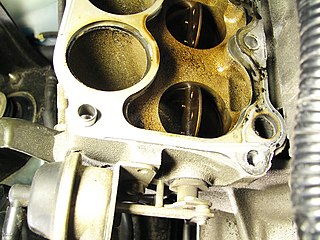
In internal combustion engines, a variable-length intake manifold (VLIM),variable intake manifold (VIM), or variable intake system (VIS) is an automobile internal combustion engine manifold technology. As the name implies, VLIM/VIM/VIS can vary the length of the intake tract in order to optimise power and torque across the range of engine speed operation, as well as to help provide better fuel efficiency. This effect is often achieved by having two separate intake ports, each controlled by a valve, that open two different manifolds – one with a short path that operates at full engine load, and another with a significantly longer path that operates at lower load. The first patent issued for a variable length intake manifold was published in 1958, US Patent US2835235 by Daimler Benz AG.

The Ford Cologne V6 is a series of 60° cast iron block V6 engines produced by the Ford Motor Company from 1962 to 2011 in displacements between 1.8 L; 110.6 cu in (1,812 cc) and 4.0 L; 244.6 cu in (4,009 cc). Originally, the Cologne V6 was installed in vehicles intended for Germany and Continental Europe, while the unrelated British Essex V6 was used in cars for the British market. Later, the Cologne V6 largely replaced the Essex V6 for British-market vehicles. These engines were also used in the United States, especially in compact trucks.
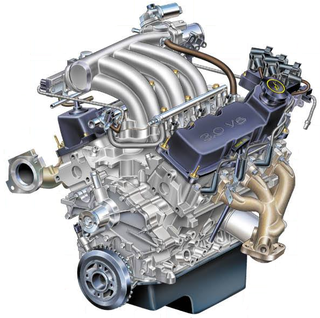
The Ford Vulcan is a 3.0 L V6 engine designed and built by the Ford Motor Company. It debuted in 1986 in the newly launched Ford Taurus. Ford went on to install the Vulcan V6 in a variety of car, van, and pickup truck models until the 2008 model year, after which production stopped.
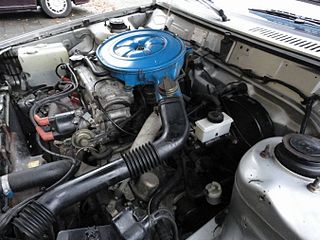
The F engine family from Mazda is a mid-sized inline-four piston engine with iron block, alloy head and belt-driven SOHC and DOHC configurations. Introduced in 1983 as the 1.6-litre F6, this engine was found in the Mazda B-Series truck and Mazda G platform models such as Mazda 626/Capella as well as many other models internationally including Mazda Bongo and Ford Freda clone, Mazda B-series based Ford Courier, Mazda 929 HC and the GD platform-based Ford Probe

The Ford SHO V6 is a family of DOHC V6 engines fitted to the Ford Taurus SHO from 1989 to 1995. The designation SHO denotes Super High Output.
Toyota Motor Corporation's A family is a family of automatic FWD/RWD/4WD/AWD transmissions built by Aisin-Warner. They share much in common with Volvo's AW7* and Aisin-Warner's 03-71* transmissions, which are found in Suzukis, Mitsubishis, and other Asian vehicles.

TorqueFlite is the trademarked name of Chrysler Corporation's automatic transmissions, starting with the three-speed unit introduced late in the 1956 model year as a successor to Chrysler's two-speed PowerFlite. In the 1990s, the TorqueFlite name was dropped in favor of alphanumeric designations, although the latest Chrysler eight-speed automatic transmission has revived the name.

Lima Engine is a Ford Motor Company automobile engine plant located in Lima, Ohio, United States.
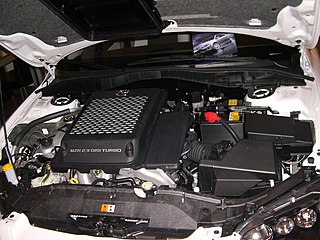
MZR is the brand name of a generation of Inline-four engines engineered and built by the Mazda Motor Corporation from 2001 to the present. MZR stands for "MaZda Responsive". The MZR generation includes gasoline and diesel powered engines ranging in displacements from 1.3L to 2.5L.
The 6R is a six-speed automatic transmission for longitudinal engine placement in rear-wheel drive vehicles. It is based on the ZF 6HP26 transmission and has been built under license by the Ford Motor Company at its Livonia Transmission plant in Livonia, Michigan. The 6R debuted in 2005 for the 2006 model year Ford Explorer and Mercury Mountaineer.
The Ford C3 transmission and its descendants are a family of light-duty longitudinal automatic transmissions built by the Ford Motor Company.
The M5OD is a line of manual transmissions produced by Mazda and used in Mazda and Ford cars and trucks. Two variants, light-duty R1 and medium duty R2, were made. R1 transmissions have been used in the Ford Ranger, Explorer, Aerostar, and Bronco II. R2 versions have been used in the F-150, Econoline Van, full size Bronco, and the Cougar/Thunderbird with the supercharged V6.

Ford Motor Company used the Zetec name on a variety of inline 4-cylinder automobile engines. It was coined to replace "Zeta" on a range of 1.6 L to 2.0 L multi-valve engines introduced in 1991 because Ford was threatened with legal action by Lancia who owned the Zeta trademark. The company used the name widely in European advertising and later introduced it to the North American market with the Contour.
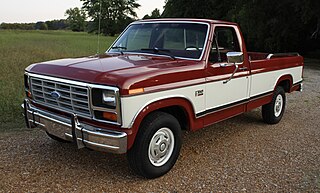
The seventh generation of the Ford F-Series is a range of trucks that was produced by Ford from the 1980 to 1986 model years. The first complete redesign of the F-Series since the 1965 model year, the seventh generation received a completely new chassis and body, distinguished by flatter body panels and a squarer grille, earning the nickname "bullnose" from enthusiasts. This generation marked several firsts for the model line, including the introduction of the Ford Blue Oval grille emblem, the introduction of a diesel engine to the model line, and a dashboard with a full set of instruments (optional). Conversely, this generation marked the end of the long-running F-100, the Ranger trim, and sealed-beam headlamps.

The ninth generation of the Ford F-Series is a lineup of trucks that were produced by Ford from the 1992 to 1998 model years. The final generation of the F-Series to include a complete range of trucks from a half-ton F-150 pickup truck to a medium-duty F-800 commercial truck, this is the third generation of the F-Series body and chassis introduced for 1980.